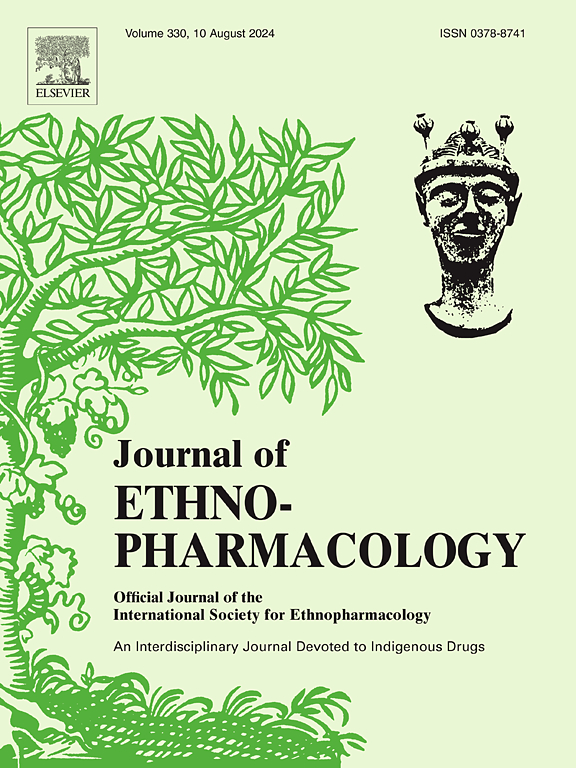An in vitro, in vivo and in silico assessment of fat absorption inhibition by a gymnemic acid rich extract of Gymnema sylvestre leaves
IF 4.8
2区 医学
Q1 CHEMISTRY, MEDICINAL
引用次数: 0
Abstract
Ethnopharmacological relevance
Hyperlipidemia is a metabolic disturbance linked to the metabolic syndrome, obesity, and diabetes. Gymnema sylvestre is a plant used in Ayurvedic folk medicine to control hyperglycemia and hyperlipidemia. These effects have received support by a fair number of investigations.
Aim of the study
The objective of this study was to elucidate the mechanisms underlying the anti-hyperlipidemic effects of a commercial extract derived from Gymnema sylvestre leaves, standardized to 75 % gymnemic acids (“Gymnema sylvestre 75”).
Materials and methods
In vivo, in vitro and in silico experiments were done, encompassing several aspects of fat absorption.
Results
Pancreatic lipase assays revealed that the extract inhibited hydrolysis of triglycerides. This effect is of the non-competitive type and incomplete (parabolic kinetics). Maximal inhibition at saturating substrate concentrations reached 65 %. Triglyceride tolerance tests in mice indicated inhibition of fat absorption with an ID50 of 41.4 mg/kg. This dose is much smaller than expected from the in vitro lipase inhibition (IC50 = 484.6 μg/mL) and suggests a more complex mechanism than the simple inhibition of the pancreatic lipase. Notably, the observed inhibition of free oleate absorption by the extract implies that inhibition of the intestinal fatty acyl transporter may represent an additional mode of action. In silico studies revealed strong binding of gymnanegin and gymnemoside B to the pancreatic lipase.
Conclusion
The inhibition of the pancreatic lipase and fatty acyl transport by the G. sylvestre extract likely play a pivotal role in reducing hyperlipidemia and promoting effective body weight control in animals.

富含藤子酸的藤子叶提取物抑制脂肪吸收的体外、体内和体内评价。
民族药理学相关性:高脂血症是一种与代谢综合征、肥胖和糖尿病相关的代谢紊乱。金盆草是印度草药中用于控制高血糖和高脂血症的植物。这些影响得到了相当数量的调查的支持。研究目的:本研究的目的是阐明一种商业萃取物的抗高脂血症作用的机制,这种萃取物来源于75%标准化的裸子藤酸(“裸子藤75”)。材料和方法:进行了体内、体外和计算机实验,包括脂肪吸收的几个方面。结果:胰脂肪酶测定显示,提取物抑制甘油三酯水解。这种效应是非竞争性的和不完全的(抛物线动力学)。在饱和底物浓度下,最大抑制率达到65%。小鼠甘油三酯耐量试验表明,其抑制脂肪吸收的ID50为41.4 mg/kg。该剂量远小于体外脂肪酶抑制的预期剂量(IC50 = 484.6 μg/mL),表明其作用机制比单纯抑制胰脂肪酶更为复杂。值得注意的是,观察到的提取物对游离油酸吸收的抑制表明,对肠道脂肪酰基转运蛋白的抑制可能是另一种作用方式。计算机研究显示,裸子皂苷和裸子皂苷B与胰脂肪酶有很强的结合。结论:芫花提取物对胰腺脂肪酶和脂肪酰基转运的抑制作用可能在降低动物高脂血症和促进有效的体重控制中起关键作用。
本文章由计算机程序翻译,如有差异,请以英文原文为准。
求助全文
约1分钟内获得全文
求助全文
来源期刊

Journal of ethnopharmacology
医学-全科医学与补充医学
CiteScore
10.30
自引率
5.60%
发文量
967
审稿时长
77 days
期刊介绍:
The Journal of Ethnopharmacology is dedicated to the exchange of information and understandings about people''s use of plants, fungi, animals, microorganisms and minerals and their biological and pharmacological effects based on the principles established through international conventions. Early people confronted with illness and disease, discovered a wealth of useful therapeutic agents in the plant and animal kingdoms. The empirical knowledge of these medicinal substances and their toxic potential was passed on by oral tradition and sometimes recorded in herbals and other texts on materia medica. Many valuable drugs of today (e.g., atropine, ephedrine, tubocurarine, digoxin, reserpine) came into use through the study of indigenous remedies. Chemists continue to use plant-derived drugs (e.g., morphine, taxol, physostigmine, quinidine, emetine) as prototypes in their attempts to develop more effective and less toxic medicinals.
 求助内容:
求助内容: 应助结果提醒方式:
应助结果提醒方式:


